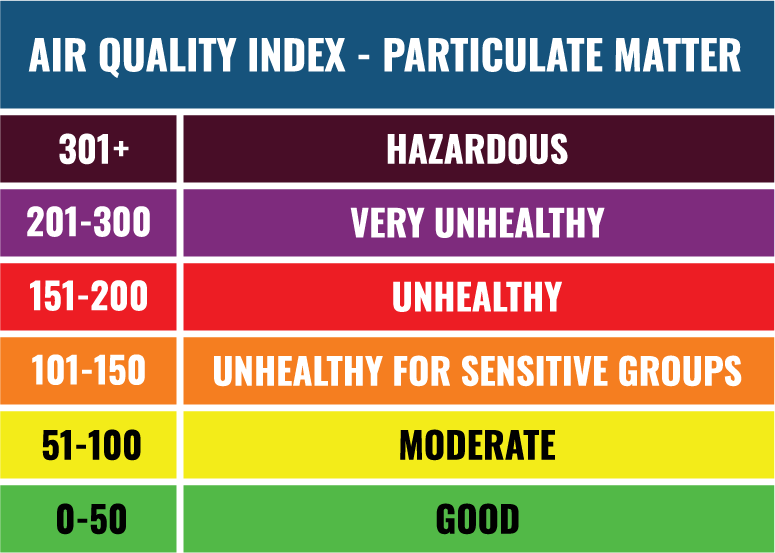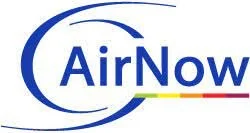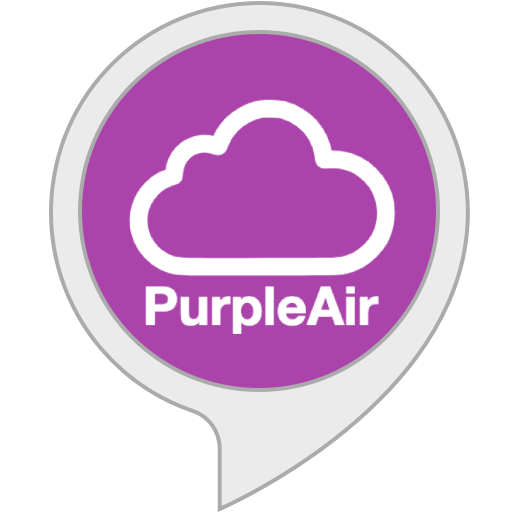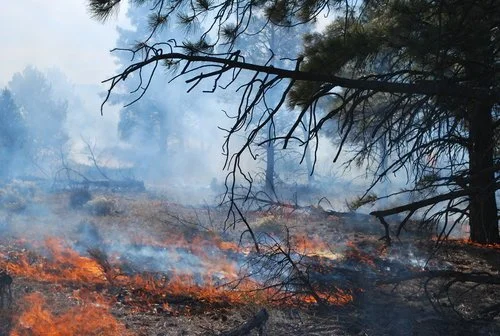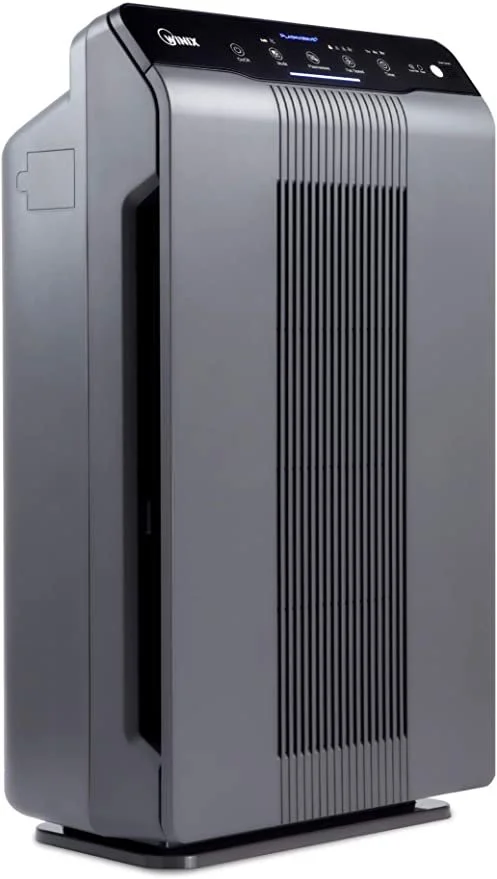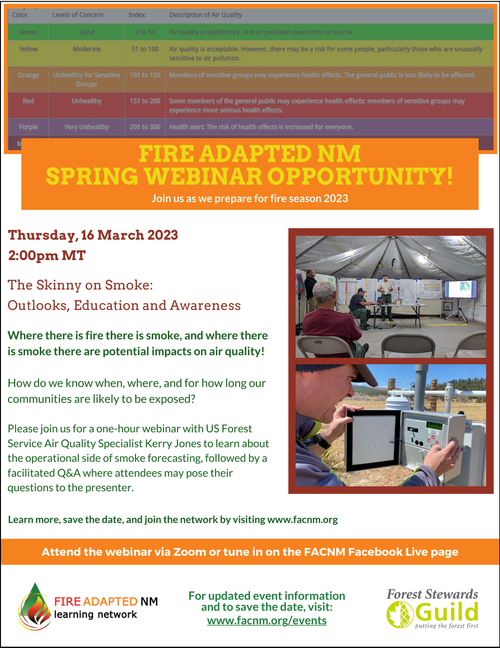Hi Fireshed Community,
As seasons begin to change, and Spring brings warmer and windier weather, it is a good time to think ahead and prepare for the realities of the upcoming fire season. Smoke from wildfires and prescribed fires is a serious concern as it can cause or exacerbate health conditions for some people living in fire-adapted communities. Living in northern New Mexico we must accept that wildfire and smoke is inevitable but there are measures we can take to reduce our risk and health effects.
To support you in smoke exposure mitigation, this Wildfire Wednesdays includes the following:
General info about AQI and PM 2.5
Air quality information - Airnow.gov and Purpleair.com
Smoke exposure mitigation
General air filtration
FACNM’s HEPA filter loan program
Smoke forecasting webinar with air quality specialist Kerry Jones - March 16th
Stay Safe,
Gabe
Wildfire Smoke Basics
Wildfire smoke is a mixture of gases and fine particles from burning trees and other plant material. The gases and fine particles can be dangerous if inhaled. In wildfires, carbon monoxide is mainly a risk to people (like firefighters) who work near smoldering areas. Smoke can irritate your eyes and your respiratory system, and worsen chronic heart and lung diseases. The amount and length of smoke exposure, as well as a person’s age and degree of susceptibility, play a role in determining if someone will experience smoke-related health problems. If you are experiencing serious medical problems for any reason, seek medical attention immediately.
Air Quality Index (AQI)
Think of the AQI as a yardstick that runs from 0 to 500. The higher the AQI value, the greater the level of air pollution and the greater the health concern. For example, an AQI value of 50 or below represents good air quality, while an AQI value over 300 represents hazardous air quality.
For each pollutant an AQI value of 100 generally corresponds to an ambient air concentration that equals the level of the short-term national ambient air quality standard for protection of public health. AQI values at or below 100 are generally thought of as satisfactory. When AQI values are above 100, air quality is unhealthy: at first for certain sensitive groups of people, then for everyone as AQI values get higher.
The AQI is divided into six categories. Each category corresponds to a different level of health concern. Each category also has a specific color. The color makes it easy for people to quickly determine whether air quality is reaching unhealthy levels in their communities.
Particulate Matter and PM 2.5
The particulate matter (also called “PM”) in wildfire smoke poses the biggest risk to the public’s health. The potential health effects vary based on the type of plants burning, atmospheric conditions and, most importantly, the size of the particles. Particles larger than 10 micrometers usually irritate only the eyes, nose and throat. Fine particles 2.5 micrometers or smaller (PM2.5) can be inhaled into the deepest part of the lungs, and may cause greater health concern.
Air Quality Information Sources
The first step to mitigating your smoke exposure is getting up-to-date, accurate information about air quality in your area. To support you in finding the best available data, we would like to introduce Airnow.gov for local AQI information and purpleair.com for information
What is Airnow.gov?
AirNow is your one-stop source for air quality data. Our recently redesigned site highlights air quality in your local area first, while still providing air quality information at state, national, and world views. A new interactive map even lets you zoom out to get the big picture or drill down to see data for a single air quality monitor.
AirNow reports air quality using the official U.S. Air Quality Index (AQI), a color-coded index designed to communicate whether air quality is healthy or unhealthy for you. When you know the AQI in your area, you can take steps to protect your health.
Click here to visit, airnow.gov.
What is Purpleair.com?
PurpleAir makes sensors that empower Community Scientists who collect hyper-local air quality data and share it with the public. PurpleAir's sensors measure particle pollution (PM2.5) both indoors and outdoors.
PurpleAir is built on the ideal of sharing data and by doing this, empowering individuals to effect change. All public PurpleAir data is available to download under various licenses from private, not for profit use to educational and commercial use.
Click here to visit purpleair.com.
Smoke Exposure Mitigation
One of the best ways to reduce the impact of smoke is by reducing the amount of smoke that enters your building and filtering harmful particles from the air. If you have a central air conditioning system in your home, set it to re-circulate or close outdoor air intakes to avoid drawing in smoky outdoor air. Upgrading the filter efficiency of the heating, ventilating, and air-conditioning (HVAC) system and changing filters frequently during smoke events greatly improves indoor air quality.
Smaller portable air cleaners are a great way to provide clean air in the areas where you spend most of your time. Essentially these are filters with an attached fan that draws air through the filter and cleans it. These cleaners can help reduce indoor particle levels, provided the specific air cleaner is properly matched to the size of the indoor environment in which it is placed, and doors and windows are kept shut. They should be placed in the bedrooms or living rooms to provide the most effectiveness.
When air quality improves, such as during a wind shift or after a rain, make sure to use natural ventilating to flush out the air in your building.
The Winix 5300-2 and 5500 is what FACNM uses for our HEPA loan program
Selecting a Filter - For either portable filters or HVAC filters make sure to select a filter that is true HEPA or has a MERV rating of 13 or higher. These ratings refer to the size of particles that the filter will remove from the air and in this case they are certified to remove particles down to .3 microns in size. This is the minimum needed to remove the small harmful particles in smoke.
When selecting a portable filter, the other rating to pay attention to is CADR or Clean Air Delivery Rate. This refers to the volume of air that passes trough the unit. A CADR of 200 means the unit provides 200 cubic feet of clean air per minute, and often this number is equated to the room size that it will effectively purify the air in. In a 300 sq foot room a filter with a rating of 200 CADR will cycle the air through the filter 4-5 times per hour. While any filter will provide clean air those with lower CADRs will simply work more slowly. Lastly, make sure to avoid filters that claim to produce ozone to destroy pathogens, as ozone is a respiratory irritant.
More information about filters and guides to selecting one can be found in the Resources section below.
Face Masks - Face masks can be an effective way to reduce your exposure to smoke when they are fit correctly and are the proper rating. Make sure the mask you use is rated at least N95 or N100 and that you take care to fit it properly. These masks will filter out the small particles that are the most hazardous to your health. Paper masks only filter out large particles and will not provide the filtration needed to protect you from smoke.
HEPA Filter Loan Program
With support from the New Mexico State University, the national Fire Adapted Communities Learning Network, and the Forest Stewards Guild, FACNM is pleased to offer this pilot HEPA Filter Loan program. These filters are available to smoke sensitive individuals during periods of smoke impacts in some areas of Northern New Mexico, but we hope to expand to more areas soon. We have a small amount of portable air cleaners that will filter the air in a large room such as a living room or bed room. These will be distributed on a first come- first served basis for predetermined time periods. You will need to provide contact info and come to office listed for your area to sign for the filter and pick it up. Please look over the HEPA Air Filter Check-Out Contract.
To view contact information for the HEPA loan program in your area, visit the FACNM smoke page.
For general information about the program contact Gabe Kohler at the Forest Stewards Guild at gabe@forestguild.org.
Upcoming Events
Webinar: The Skinny on Smoke - Outlooks, Education and Awareness
Thursday, March 16, 2023 2:00 PM 3:00 PM
Click here for full event information and to register.
Where there is fire there is smoke, and where there is smoke there are potential impacts on air quality!
How do we know when, where, and for how long our communities are likely to be exposed?
In this one-hour presentation, Air Quality Specialist Kerry Jones will discuss various facets of smoke projections, including what goes into generating seasonal outlooks and fire weather forecasts, the weather conditions that are most conducive to fire and to smoke, and how determinations of air quality are made along with the decision to send air quality advisory alerts out to the public.
Please join us to learn about the operational side of smoke forecasting, followed by a facilitated Q&A session where attendees may pose their questions to the presenter.
When: Thursday, March 16th from 2-3pm MT
Where: Zoom and FACNM Facebook Live
Who: Kerry Jones, USFS Air Quality Specialist


